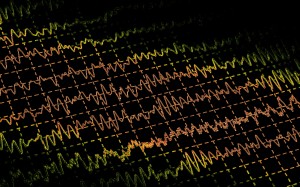
Attention deficit hyperactivity disorder (ADHD) is common with a prevalence of between 5 and 8%. It is often thought of as a problem with young people and is most commonly diagnosed in individuals while they are attending school. Unfortunately ADHD can have disruptive effects across the lifetimes of those affected. It can be and is associated with failure at school, problems relating to others, mental illness and even delinquency. The main symptoms of ADHD are inattention, over-activity and impulsiveness that is inappropriate for the individual’s age. These symptoms are persistent and pervasive.
Individuals with ADHD are usually treated using a number of different methods at the same time. These methods might include drugs, food-based/dietary interventions and talking treatments. Medication can be effective, but can often negatively affect the sleep, appetite and growth of the child involved.
While it would be wrong to say that non-drug interventions have no side-effects at all, it would seem to be a good idea to not solely rely on medicines for the treatment of children. Unfortunately the effectiveness of non-drug interventions for ADHD is not known. As such the authors of this paper performed a systematic review and meta-analysis of the effectiveness of diet and talking interventions in treating the main symptoms of ADHD.
Method
A broad range of electronic databases were searched for randomised controlled trials (RCTs) involving food-based or talking treatments for ADHD. To be included in the overall analysis the papers had to meet a number of conditions:
- RCTs published in peer reviewed journals
- Studies with participants aged 3-18 years with a diagnosis of ADHD
- Treatments in the studies could include drugs but not where the intervention was combined with drugs into a single therapy
- Studies dependent on the presence of rare conditions occurring with ADHD (e.g. Fragile X Syndrome) were excluded
Once the appropriate studies had been identified, the results were combined to see if there were statistically significant effects for talking or food-based interventions on ADHD.
Results
54 out of 2,904 screened studies were included in the analysis. Three main types of food-based intervention were identified and three main types of psychological intervention.
Dietary Interventions:
- Restricted elimination diets
- Artificial food colouring exclusion
- Free fatty acid supplementation
All of the food-based interventions had significant effects on ADHD symptoms when rated by those closest to the setting where therapy occurred (e.g. parents or teachers). Only artificial food colouring exclusion (Effect size, Z=2.86, p=0.004) and free fatty acid supplementation (Z=2.05, p=0.04) showed effects when the people rating symptoms didn’t know which treatment the child with ADHD was receiving. However the size of these effects was not large.
Psychological Interventions:
- Cognitive training
- Neurofeedback
- Behavioural interventions
All of the talking interventions had significant effects on ADHD symptoms when rated by parents or teachers. None of the talking therapies were shown to improve symptoms when the people rating symptoms didn’t know which treatment the participants were receiving.
Conclusions
- All of the food and talking-based treatments produced statistically significant effects on ADHD symptoms when ratings by parents or teachers were taken into account
- Out of all the treatments only two of the food-based treatments showed effects on ADHD symptoms when ratings of symptoms were taken from people who did not know what treatment the children they were rating were receiving.
- However, statistical or mathematically significant effects are not the same as clinical significant effects or effects seen in the “real” world. Whether the food-based treatments can have this sort of effect remains to be seen.
Limitations
In the analysis, the removal of artificial food colouring from the childrens’ diets was shown to improve symptoms of ADHD. However in the studies where this was the case the children had been selected for the research because they were already thought to have symptoms worsened by having artificial food colourings.
Though talking interventions were not statistically effective for treating core ADHD symptoms these interventions may have other positive effects not looked at in this study. For example they may help reduce oppositional or argumentative behaviour.
Summary
Food-based treatments, particularly artificial food colouring exclusion and free fatty acid supplementation had a small but statistically significant impact on ADHD symptoms. More evidence is needed before psychological interventions can be recommended for treating the core ADHD symptoms. Indeed more evidence of impact on ADHD symptoms from food-based interventions is needed as it isn’t known whether the small effects shown in this study would translate into real world improvements.
Links
Sonuga-Barke EJ, Brandeis D, Cortese S. et al. Nonpharmacological Interventions for ADHD: Systematic Review and Meta-Analyses of Randomized Controlled Trials of Dietary and Psychological Treatments. Am J Psychiatry 2103; Mar 1;170(3):pp 275-89. [Abstract]
Willcutt EG. The prevalence of DSM-IV attention-deficit/hyperactivity disorder: a meta-analytic review. Neurotherapeutics. 2012; Jul;9(3):pp 490-9. [PubMed abstract]



Systematic review finds limited evidence for non-drug treatments of ADHD. A brief summary I did for @Mental_Elf http://t.co/HhTtDAgDy2
Excellent post by @hullodave: New systematic review finds limited evidence for non-drug treatments for ADHD http://t.co/qis5VIWSNz
Interesting because of bias in opinion when knowing treatment or not #hsw #sciteachjc #asechat http://t.co/exvcjpdzdv
@Mental_Elf. Things that can help reduce severity are non-use of processed, additive-polluted food and drink, and clean (non-exhaust) air.
Artificial food colouring exclusion & free fatty acid supplementation may reduce #ADHD symptoms http://t.co/ueYYBqJbGG
@Mental_Elf interesting. Would lilke to see them compared to standard drug treatment.
@LeahFHardy @Mental_Elf AAP hinted at this since 2008 (even before Peslser INCA study) see Grand Rounds editorial… http://t.co/1uzX1cNDxu
@QuestAnswers @Mental_Elf my son is extremely sensitive to certain food colours. Even he hates what happens to him.
New systematic review finds limited evidence for non-drug treatments for ADHD http://t.co/sJqIroHeQF
New systematic review looks at food-based and talking-based treatments for #ADHD http://t.co/pCEABDsMJ7
“@Mental_Elf: New systematic review looks at food-based and talking-based treatments for #ADHD http://t.co/XPb7i8CTzV” @biancahabib1
Limited evidence for non-drug treatments for ADHD. Short review of a systematic review for @Mental_Elf by me. http://t.co/hDHuRiluFL
RT @hullodave: Limited evidence for non-drug treatments for ADHD. Short review of a systematic review. http://t.co/L7QMGvovE5
Limited evidence for non-drug treatments for ADHD. http://t.co/O2gff63TN8
Limits of non-drug treatments for ADHD http://t.co/WXOPlcgQzy #neuro
New systematic review finds limited evidence for non-drug treatments for #ADHD » The Mental Elf http://t.co/OVeEbQ6M4s #rvsed